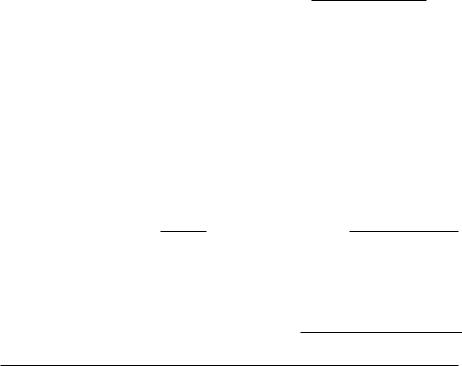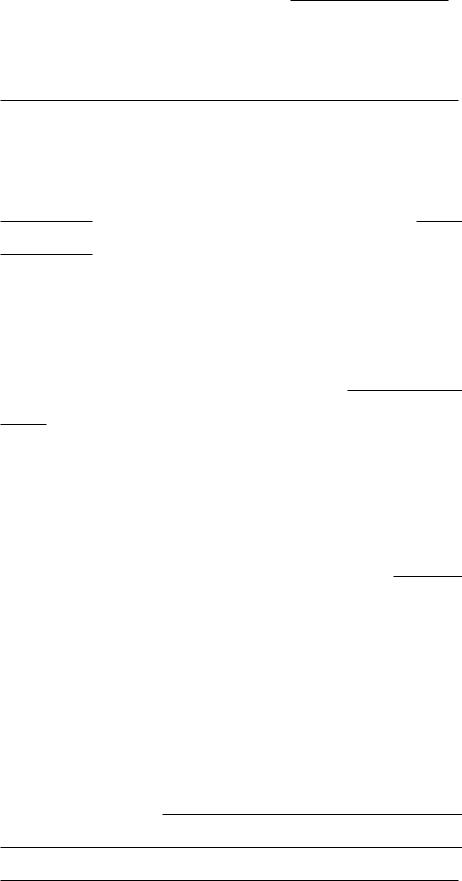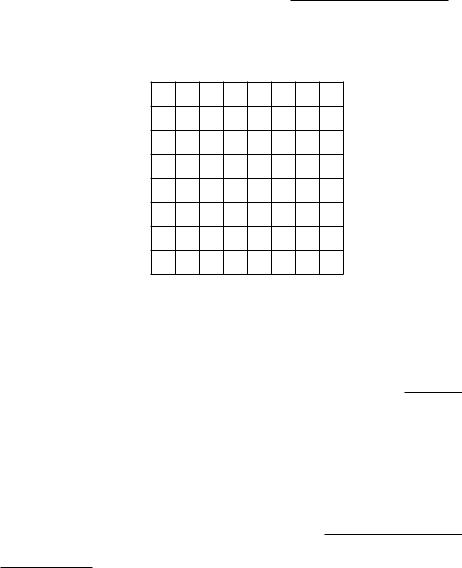
Varian Microeconomics Workout
.pdf
In this chapter you will solve problems for ¯rm and industry outcomes when the ¯rms engage in Cournot competition, Stackelberg competition, and other sorts of oligopoly behavior. In Cournot competition, each ¯rm chooses its own output to maximize its pro¯ts given the output that it expects the other ¯rm to produce. The industry price depends on the industry output, say, qA + qB, where A and B are the ¯rms. To maximize pro¯ts, ¯rm A sets its marginal revenue (which depends on the output of ¯rm A and the expected output of ¯rm B since the expected industry price depends on the sum of these outputs) equal to its marginal cost. Solving this equation for ¯rm A's output as a function of ¯rm B's expected output gives you one reaction function; analogous steps give you ¯rm B's reaction function. Solve these two equations simultaneously to get the Cournot equilibrium outputs of the two ¯rms.
In Heifer's Breath, Wisconsin, there are two bakers, Anderson and Carlson. Anderson's bread tastes just like Carlson's|nobody can tell the di®erence. Anderson has constant marginal costs of $1 per loaf of bread. Carlson has constant marginal costs of $2 per loaf. Fixed costs are zero for both of them. The inverse demand function for bread in Heifer's Breath is p(q) = 6 ¡ :01q, where q is the total number of loaves sold per day.
Let us ¯nd Anderson's Cournot reaction function. If Carlson bakes qC loaves, then if Anderson bakes qA loaves, total output will be qA + qC and price will be 6 ¡ :01(qA + qC). For Anderson, the total cost of producing qA units of bread is just qA, so his pro¯ts are
pqA ¡ qA = (6 ¡ :01qA ¡ :01qC)qA ¡ qA = 6qA ¡ :01qA2 ¡ :01qCqA ¡ qA:
Therefore if Carlson is going to bake qC units, then Anderson will choose qA to maximize 6qA ¡:01qA2 ¡:01qCqA ¡qA. This expression is maximized when 6 ¡ :02qA ¡ :01qC = 1. (You can ¯nd this out either by setting A's marginal revenue equal to his marginal cost or directly by setting the derivative of pro¯ts with respect to qA equal to zero.) Anderson's reaction function, RA(qC) tells us Anderson's best output if he knows that Carlson is going to bake qC. We solve from the previous equation to
¯nd RA(qC) = (5 ¡ :01qC)=:02 = 250 ¡ :5qC.
We can ¯nd Carlson's reaction function in the same way. If Carlson knows that Anderson is going to produce qA units, then Carlson's pro¯ts
will be p(qA +qC)¡2qC = (6¡:01qA ¡:01qC)qC ¡2qC = 6qC ¡:01qAqC ¡ :01qC2 ¡2qC: Carlson's pro¯ts will be maximized if he chooses qC to satisfy
the equation 6 ¡:01qA ¡:02qC = 2. Therefore Carlson's reaction function
is RC(qA) = (4 ¡ :01qA)=:02 = 200 ¡ :5qA.
Let us denote the Cournot equilibrium quantities by q¹A and q¹C. The Cournot equilibrium conditions are that q¹A = RA(¹qC) and q¹C = RC(¹qA).
Solving these two equations in two unknowns we ¯nd that q¹A = 200 and q¹C = 100. Now we can also solve for the Cournot equilibrium price and for the pro¯ts of each baker. The Cournot equilibrium price is 6 ¡ :01(200 + 100) = $3. Then in Cournot equilibrium, Anderson makes a pro¯t of $2 on each of 200 loaves and Carlson makes $1 on each of 100 loaves.
In Stackelberg competition, the follower's pro¯t-maximizing output choice depends on the amount of output that he expects the leader to produce. His reaction function, RF (qL), is constructed in the same way as for a Cournot competitor. The leader knows the reaction function of the follower and gets to choose her own output, qL, ¯rst. So the leader knows that the industry price depends on the sum of her own output and the follower's output, that is, on qL + RF (qL). Since the industry price can be expressed as a function of qL only, so can the leader's marginal revenue. So once you get the follower's reaction function and substitute it into the inverse demand function, you can write down an expression that depends on just qL and that says marginal revenue equals marginal cost for the leader. You can solve this expression for the leader's Stackelberg output and plug in to the follower's reaction function to get the follower's Stackelberg output.
Suppose that one of the bakers of Heifer's Breath plays the role of Stackelberg leader. Perhaps this is because Carlson always gets up an hour earlier than Anderson and has his bread in the oven before Anderson gets started. If Anderson always ¯nds out how much bread Carlson has in his oven and if Carlson knows that Anderson knows this, then Carlson can act like a Stackelberg leader. Carlson knows that Anderson's reaction function is RA(qC) = 250 ¡ :5qc. Therefore Carlson knows that if he bakes qC loaves of bread, then the total amount of bread that will be baked in Heifer's Breath will be qC + RA(qC) = qC + 250 ¡ :5qC = 250 + :5qC. Since Carlson's production decision determines total production and hence the price of bread, we can write Carlson's pro¯t simply as a function of his own output. Carlson will choose the quantity that maximizes this pro¯t. If Carlson bakes qC loaves, the price will be p = 6 ¡ :01(250 + :5qC) = 3:5 ¡ :005qC. Then Carlson's pro¯ts will be
pqC ¡ 2qC = (3:5 ¡ :005qC)qC ¡ 2qC = 1:5qC ¡ :005qC2 . His pro¯ts are maximized when qC = 150. (Find this either by setting marginal revenue
equal to marginal cost or directly by setting the derivative of pro¯ts to zero and solving for qC.) If Carlson produces 150 loaves, then Anderson will produce 250 ¡ :5 £ 150 = 175 loaves. The price of bread will be 6 ¡ :01(175 + 150) = 2:75. Carlson will now make $.75 per loaf on each of 150 loaves and Anderson will make $1.75 on each of 175 loaves.
27.1 (0) Carl and Simon are two rival pumpkin growers who sell their pumpkins at the Farmers' Market in Lake Witchisit, Minnesota. They are the only sellers of pumpkins at the market, where the demand function for pumpkins is q = 3; 200 ¡ 1; 600p. The total number of pumpkins sold at the market is q = qC + qS, where qC is the number that Carl sells and qS is the number that Simon sells. The cost of producing pumpkins for either farmer is $.50 per pumpkin no matter how many pumpkins he produces.

(a) The inverse demand function for pumpkins at the Farmers' Market is
p = a ¡ b(qC + qS), where a = |
|
and b = |
|
|
The |
|
|
|
|
||||
marginal cost of producing a pumpkin for either farmer is |
|
|
. |
|||
(b) Every spring, each of the farmers decides how many pumpkins to grow. They both know the local demand function and they each know how many pumpkins were sold by the other farmer last year. In fact, each farmer assumes that the other farmer will sell the same number this year as he sold last year. So, for example, if Simon sold 400 pumpkins last year, Carl believes that Simon will sell 400 pumpkins again this year. If Simon sold 400 pumpkins last year, what does Carl think the price of
pumpkins will be if Carl sells 1,200 pumpkins this year? |
|
If |
Simon sold qSt¡1 pumpkins in year t ¡ 1, then in the spring of year t, Carl thinks that if he, Carl, sells qCt pumpkins this year, the price of pumpkins
this year will be |
|
. |
(c) If Simon sold 400 pumpkins last year, Carl believes that if he sells qCt pumpkins this year then the inverse demand function that he faces is p = 2 ¡ 400=1; 600 ¡ qCt =1; 600 = 1:75 ¡ qCt =1; 600. Therefore if Simon sold 400 pumpkins last year, Carl's marginal revenue this year will be 1:75 ¡ qCt =800. More generally, if Simon sold qSt¡1 pumpkins last year, then Carl believes that if he, himself, sells qCt pumpkins this year, his
marginal revenue this year will be |
|
. |
(d) Carl believes that Simon will never change the amount of pumpkins that he produces from the amount qSt¡1 that he sold last year. Therefore Carl plants enough pumpkins this year so that he can sell the amount that maximizes his pro¯ts this year. To maximize this pro¯t, he chooses the output this year that sets his marginal revenue this year equal to his marginal cost. This means that to ¯nd Carl's output this year when Simon's output last year was qSt¡1, Carl solves the following equation.
.
(e) Carl's Cournot reaction function, RCt (qSt¡1), is a function that tells us what Carl's pro¯t-maximizing output this year would be as a function of Simon's output last year. Use the equation you wrote in the last answer
to ¯nd Carl's reaction function, RCt (qSt¡1) = |
|
(Hint: |
|
This is a linear expression of the form a ¡ bqSt¡1. You have to ¯nd the constants a and b.)

(f) Suppose that Simon makes his decisions in the same way that Carl does. Notice that the problem is completely symmetric in the roles played by Carl and Simon. Therefore without even calculating it, we can guess
that Simon's reaction function is RSt (qCt¡1) = (Of course, if you don't like to guess, you could work this out by following similar steps to the ones you used to ¯nd Carl's reaction function.)
(g) Suppose that in year 1, Carl produced 200 pumpkins and Simon produced 1,000 pumpkins. In year 2, how many would Carl produce?
|
|
How many would Simon produce? |
|
In year 3, |
|||
how many would Carl produce? |
|
How many would Simon |
|||||
produce? |
|
|
Use a calculator or pen and paper to work out sev- |
||||
|
|
||||||
eral more terms in this series. To what level of output does Carl's output
appear to be converging? How about Simon's? .
(h) Write down two simultaneous equations that could be solved to ¯nd outputs qS and qC such that, if Carl is producing qC and Simon is producing qS, then they will both want to produce the same amount in the
next period. (Hint: Use the reaction functions.)
.
(i) Solve the two equations you wrote down in the last part for an equilibrium output for each farmer. Each farmer, in Cournot equilibrium, pro-
duces |
|
units of output. The total amount of pumpkins brought to |
|||||
the Farmers' Market in Lake Witchisit is |
|
The price of pump- |
|||||
kins in that market is |
|
How much pro¯t does each farmer make? |
|||||
|
|
|
|
|
|
. |
|
27.2 (0) Suppose that the pumpkin market in Lake Witchisit is as we described it in the last problem except for one detail. Every spring, the snow thaws o® of Carl's pumpkin ¯eld a week before it thaws o® of Simon's. Therefore Carl can plant his pumpkins one week earlier than Simon can. Now Simon lives just down the road from Carl, and he can tell by looking at Carl's ¯elds how many pumpkins Carl planted and how many Carl will harvest in the fall. (Suppose also that Carl will sell every pumpkin that he produces.) Therefore instead of assuming that Carl will sell the same amount of pumpkins that he did last year, Simon sees how many Carl is actually going to sell this year. Simon has this information before he makes his own decision about how many to plant.

(a) If Carl plants enough pumpkins to yield qCt this year, then Simon knows that the pro¯t-maximizing amount to produce this year is qSt = Hint: Remember the reaction functions you found in the last problem.
.
(b) When Carl plants his pumpkins, he understands how Simon will make his decision. Therefore Carl knows that the amount that Simon will produce this year will be determined by the amount that Carl produces. In particular, if Carl's output is qCt , then Simon will produce and sell
and the total output of the two producers will be
Therefore Carl knows that if his own output is qC, the
price of pumpkins in the market will be |
|
. |
(c) In the last part of the problem, you found how the price of pumpkins this year in the Farmers' Market is related to the number of pumpkins that Carl produces this year. Now write an expression for Carl's total
revenue in year t as a function of his own output, qCt .
Write an expression for Carl's marginal revenue in year t as a
function of qt . |
|
|
|
|
|
. |
C |
|
|
|
|||
(d) Find the pro¯t-maximizing output for Carl. |
|
Find the |
||||
|
||||||
pro¯t-maximizing output for Simon. |
|
|
Find the equilibrium |
|||
price of pumpkins in the Lake Witchisit Farmers' Market.
How much pro¯t does Carl make? |
|
How much pro¯t does |
||||
Simon make? |
|
|
An equilibrium of the type we discuss here is |
|||
known as a |
|
|
|
equilibrium. |
|
|
(e) If he wanted to, it would be possible for Carl to delay his planting until the same time that Simon planted so that neither of them would know the other's plans for this year when he planted. Would it be in Carl's interest to do this? Explain. (Hint: What are Carl's pro¯ts in the equilibrium above? How do they compare with his pro¯ts
in Cournot equilibrium?)
.

27.3 (0) Suppose that Carl and Simon sign a marketing agreement. They decide to determine their total output jointly and to each produce the same number of pumpkins. To maximize their joint pro¯ts, how many
pumpkins should they produce in toto? |
|
How much does each |
||||
one of them produce? |
|
How much pro¯t does each one of them |
||||
make? |
|
|
|
|
. |
|
27.4 (0) The inverse market demand curve for bean sprouts is given by P (Y ) = 100 ¡2Y , and the total cost function for any ¯rm in the industry is given by T C(y) = 4y.
(a) The marginal cost for any ¯rm in the industry is equal to |
|
The |
||
change in price for a one-unit increase in output is equal to |
|
|
. |
|
(b) If the bean-sprout industry were perfectly competitive, the industry
output would be |
|
, and the industry price would be |
|
. |
(c) Suppose that two Cournot ¯rms operated in the market. The reac-
tion function for Firm 1 would be |
|
(Reminder: Unlike |
the example in your textbook, the marginal cost is not zero here.) The
reaction function of Firm 2 would be If the ¯rms were operating at the Cournot equilibrium point, industry output would be
|
|
, each ¯rm would produce |
|
, and the market price |
|
would be |
|
|
. |
||
(d) For the Cournot case, draw the two reaction curves and indicate the equilibrium point on the graph below.

y2
24
18
12
6
0 |
6 |
12 |
18 |
24 |
|
|
|
|
y1 |
(e) If the two ¯rms decided to collude, industry output would be
and the market price would equal |
|
. |
(f) Suppose both of the colluding ¯rms are producing equal amounts of output. If one of the colluding ¯rms assumes that the other ¯rm would not react to a change in industry output, what would happen to a ¯rm's
own pro¯ts if it increased its output by one unit?
(g) Suppose one ¯rm acts as a Stackleberg leader and the other ¯rm behaves as a follower. The maximization problem for the leader can be
written as |
|
|
|
|
|
. |
|
Solving this problem results in the leader producing an output of |
|||||||
|
|
and the follower producing |
|
This implies an industry |
|||
|
|
|
|||||
output of |
|
and price of |
|
|
. |
||
27.5 (0) Grinch is the sole owner of a mineral water spring that costlessly burbles forth as much mineral water as Grinch cares to bottle. It costs Grinch $2 per gallon to bottle this water. The inverse demand curve for Grinch's mineral water is p = $20 ¡ :20q, where p is the price per gallon and q is the number of gallons sold.

(a) Write down an expression for pro¯ts as a function of q: ¦(q) =
Find the pro¯t-maximizing choice of q for Grinch.
.
(b) What price does Grinch get per gallon of mineral water if he produces
the pro¯t-maximizing quantity? |
|
How much pro¯t does he |
||
make? |
|
|
. |
|
(c) Suppose, now, that Grinch's neighbor, Grubb ¯nds a mineral spring that produces mineral water that is just as good as Grinch's water, but that it costs Grubb $6 a bottle to get his water out of the ground and bottle it. Total market demand for mineral water remains as before. Suppose that Grinch and Grubb each believe that the other's quantity decision is independent of his own. What is the Cournot equilibrium out-
put for Grubb? |
|
What is the price in the Cournot equilibrium? |
.
27.6 (1) Albatross Airlines has a monopoly on air travel between Peoria and Dubuque. If Albatross makes one trip in each direction per day, the demand schedule for round trips is q = 160¡2p, where q is the number of passengers per day. (Assume that nobody makes one-way trips.) There is an \overhead" ¯xed cost of $2,000 per day that is necessary to °y the airplane regardless of the number of passengers. In addition, there is a marginal cost of $10 per passenger. Thus, total daily costs are $2; 000+10q if the plane °ies at all.
(a) On the graph below, sketch and label the marginal revenue curve, and the average and marginal cost curves.
AC, MR, MC
80
60
40
20
0 |
20 |
40 |
60 |
80 |
|
|
|
|
q |

(b) Calculate the pro¯t-maximizing price and quantity and total daily
pro¯ts for Albatross Airlines. p = |
|
, q = |
|
, ¼ = |
|
.
(c) If the interest rate is 10% per year, how much would someone be willing to pay to own Albatross Airlines's monopoly on the Dubuque-Peoria route. (Assuming that demand and cost conditions remain unchanged
forever.) |
|
. |
(d) If another ¯rm with the same costs as Albatross Airlines were to enter the Dubuque-Peoria market and if the industry then became a Cournot
duopoly, would the new entrant make a pro¯t?
.
(e) Suppose that the throbbing night life in Peoria and Dubuque becomes widely known and in consequence the population of both places doubles. As a result, the demand for airplane trips between the two places doubles to become q = 320¡4p. Suppose that the original airplane had a capacity of 80 passengers. If AA must stick with this single plane and if no other airline enters the market, what price should it charge to maximize its
output and how much pro¯t would it make? p = |
|
, ¼ = |
|
. |
(f) Let us assume that the overhead costs per plane are constant regardless of the number of planes. If AA added a second plane with the same costs
and capacity as the ¯rst plane, what price would it charge?
How many tickets would it sell? |
|
How much would its pro¯ts |
||||
be? |
|
If AA could prevent entry by another competitor, would |
||||
|
||||||
it choose to add a second plane? |
|
|
. |
|||
(g) Suppose that AA stuck with one plane and another ¯rm entered the market with a plane of its own. If the second ¯rm has the same cost function as the ¯rst and if the two ¯rms act as Cournot oligopolists, what
will be the price, |
|
, quantities, |
|
, and pro¯ts? |
|
. |
27.7 (0) Alex and Anna are the only sellers of kangaroos in Sydney, Australia. Anna chooses her pro¯t-maximizing number of kangaroos to sell, q1, based on the number of kangaroos that she expects Alex to sell. Alex knows how Anna will react and chooses the number of kangaroos that

she herself will sell, q2, after taking this information into account. The inverse demand function for kangaroos is P (q1 + q2) = 2; 000 ¡ 2(q1 + q2). It costs $400 to raise a kangaroo to sell.
(a) Alex and Anna are Stackelberg competitors. |
|
is the leader |
||
and |
|
is the follower. |
|
|
(b) If Anna expects Alex to sell q2 kangaroos, what will her own marginal
revenue be if she herself sells q1 kangaroos? |
|
|
. |
|
|
||
(c) What is Anna's reaction function, R(q2)? |
|
. |
|
|
|||
(d) Now if Alex sells q2 kangaroos, what is the total number of kangaroos
that will be sold? |
|
|
|
What will be the market price as a |
|||||||
function of q2 only? |
|
|
|
|
|
|
|
. |
|||
|
|
|
|
|
|
|
|||||
(e) What is Alex's marginal revenue as a function of q2 only? |
|
|
|
||||||||
|
|
|
|||||||||
|
|
How many kangaroos will Alex sell? |
|
|
How |
||||||
many kangaroos will Anna sell? |
|
|
What will the industry price |
||||||||
be? |
|
|
|
|
|
. |
|||||
27.8 (0) Consider an industry with the following structure. There are 50 ¯rms that behave in a competitive manner and have identical cost functions given by c(y) = y2=2. There is one monopolist that has 0 marginal costs. The demand curve for the product is given by
D(p) = 1; 000 ¡ 50p:
(a) What is the supply curve of one of the competitive ¯rms?
The total supply from the competitive sector at price p is S(p) =
.
(b) If the monopolist sets a price p, the amount that it can sell is Dm(p) =
.
